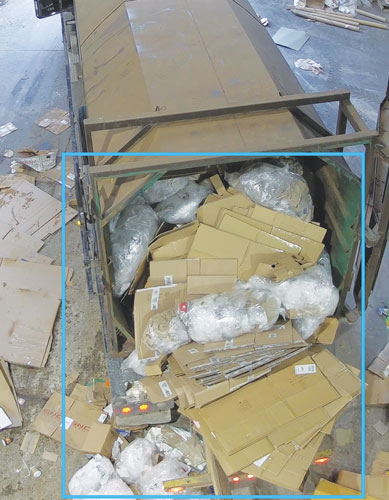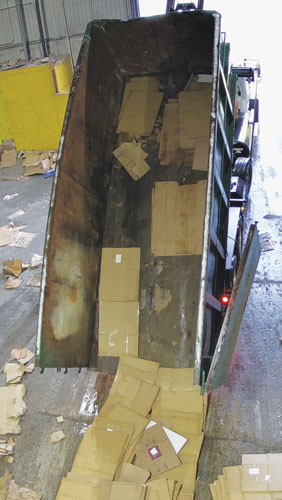Working with your haulers to build content around the data you gather looking at the material still contaminating the recycling stream is the first step to achieve 100 percent clean loads and increasing the profitability of your MRF.
By Julian Chosson
What if there was a way to curb the worst nightmare of MRFs? Contamination in recycling occurs either when materials are missorted or not properly cleaned. Unfortunately, haulers can carry contaminated material to the MRF. While the material will be sorted once it arrives at the facility, ultimately, this impacts MRF profitability, as there is a loss in potential revenue, and it also may divert more material toward the landfill. One method to curb this contamination is through education in the form of feedback to the haulers. This can be done by giving them data to better educate their own customers and communities.
By conducting an analysis of the types of contaminants making their way into the recycling stream, and addressing the contamination in a continuous manner, it is more likely that habits will change at the source. By educating well and often about the importance of mitigating contamination in recyclable material, recycling rates are likely to improve, and thus, profitability as well.

camera. Plastic bags that do not belong to the cardboard stream of the MRF.
Contamination is an Issue Throughout the Recycling Process
All loads and streams unfortunately can be contaminated. No single stream is safe from this. However, most of the time contamination happens due to a lack of understanding of the recycling process.
Understanding the intricacies of what can go in what container can be difficult for employees to comprehend as the rules change from MRF to MRF, city to city, it requires a constant level of attention we are just not used to give about our wastes, and despite large investments in sensibilization campaigns on behalf of the employer, it remains largely misunderstood that all recycling does not work the same everywhere.
Proper communication, directly from the MRF and haulers, is one of the key ways to mitigate contamination at the source: if the person sorting the waste is well aware of the restrictions for each material, as well as the consequences of wrongly sorting material, they will be less likely to haphazardly dispose of materials that may contaminate the load it was going to be disposed in. The message needs to be consistent, clear, and communicated in simple and easy-to-understand ways. It should also be brought up frequently so that it becomes a reinforced habit.
Giving Feedback to Haulers is Important
Do not be afraid to let your haulers know if some of their loads are the source of contamination. However, you may need to specify how they can improve, so be ready to not just advise them that there are mistakes being made, but also how to curb them and participate in the joint education effort to their communities.
In that vein, use data to leverage your targeted improvement campaign. Target those loads that are brought into the MRF and focus your effort on giving them detailed feedback on the stream, any
contaminated material and how it can be improved. By tracking this data, you also have the benefit of being able to track progress amongst your haulers, and perhaps identify which strategy works best for each of them.
Consistency is Key to Curb Contaminations
Reducing contamination has a direct effect on profits for your MRF. Therefore, the appropriate time and energy should be invested in consistently delivering key messaging and feedback to continue to improve metrics. How can you do that? By checking every load, every time, so that the MRF can work with the hauler on any contaminated material they bring in. Consistent feedback goes hand-in-hand with engagement: the more they are aware of what is being brought in, the more likely it is to result in a transition to cleaner material.
Better Done than Perfect
It can seem difficult—if not near impossible—to check every load, every time, and never miss anything or anyone. But it is important to remember that even though it might not be perfect, the checks need to be done. Improvement can take years, but so long as there is a continuous feedback cycle, recycling material streams can be improved.
There are also a few simple ways to ensure continuous feedback and improvement at the MRF, such as putting a manager on deck to supervise or providing employees with tablets so they can take photos and fill forms with each load. Increasingly, there are even ways to externalize this process by setting up an artificial intelligence-powered camera that can detect wrongfully sorted material right at the tipping floor and help speed up the process and deliver consistent results, so you can concentrate on running your business.

cardboard stream.
Trust the Process
It might eventually become tedious to have to remind people to keep a close eye on their loads. However, remember that the more consistent, concise and constant this feedback becomes, the higher the likelihood of you seeing lasting results. Use the data you have at hand to communicate information and engage with haulers. Make it easy for them to see the effect of contamination, by attaching photos so they can see the scale of the problem. Then, check their progress on a monthly or quarterly basis, while setting clear goals for them to reach and an action plan to work with.
Once a hauler knows which load, and therefore which route is contaminating, it can focus its education and communications efforts towards either this specific neighborhood, demographics or companies. New ways to communicate that were financially out-of-reach before because it was too costly now could become a reality. Haulers may share that data with their communities to invest in targeted education efforts, get better results for each dollar spent. Because it is targeted, it can be more impactful beyond the traditional flyer—a team can visit a neighborhood to directly talk to each person, an event can be run in a specific community, even Facebook ads are a powerful tool when you know exactly who and where your targeted audience is.
Sharing the feedback data with all the parties concerned is critical for communication toward the contaminating customers. It may result in haulers putting into place specific pricing for each community based on their contamination level, which would help the MRF and hauler cut their losses due to contaminations.
Every few months, your team should come together to analyze the progress that has been made and brainstorm new ideas with your haulers to further achieve the goals set at the MRF and in collection. By involving them in the process, you may even discover a way to be more consistent as you work together towards a common goal. Continuous feedback will allow you to measure the efficiency of your communications and education efforts, all while improving your ROI for all future investments.
Which Results Can You Expect in the Short Term?
The good news is once you start working with hauler to curb the material that is being contaminated, you can expect to see near immediate targeted actions for both your MRF and the hauler to educate their communities. You will also have the opportunity to price these contaminations, generating new revenue where it was lost previously. This is a great way to educate or cascade costs towards the communities served. A hauler could not only generate revenues, but also incline their customers to adopt faster behavioral change.
Therefore, check out how you can start giving continuous feedbacks today, and how leveraging this data may significantly increase the profitability of your MRF. Ultimately, to be successful, you will have to work on the long run with your haulers to build content around the data you gather to look at the material still contaminating the recycling stream. Monitoring this from the tipping floor, to generate valuable data is the first step to achieve 100 percent clean loads. | WA
Julien Chosson, MBA, is CEO at Wastack. After spending four years providing services for landfills across North America, he focused on helping Wastack make the circular economy sustainable and now works with transfer stations and MRFs to help them monetize their waste streams further while aligning with recycling and circular goals. Julien can be reached at [email protected].
